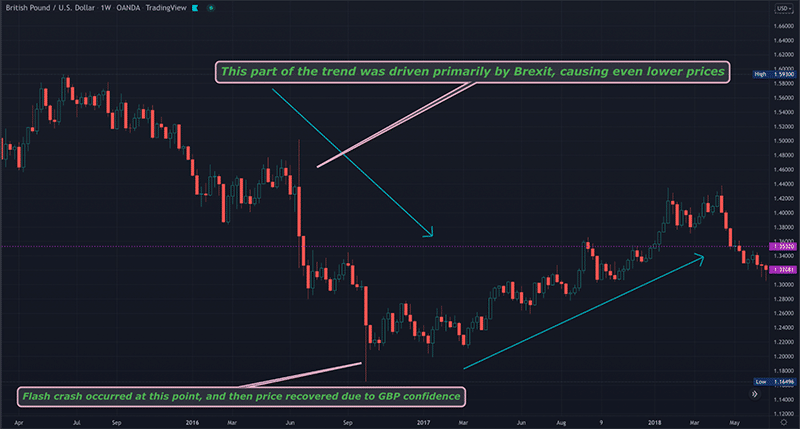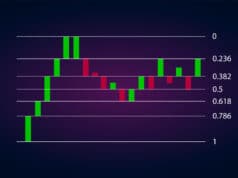January 2021 saw one of the most publicized short squeezes in history primarily driven by WallStreetBets, a subreddit known for aggressive, high-risk investments.
The financial market this group targeted was the stock of the American chain of video stores named GameStop. This company was seen as undervalued by WallStreetsBets’ ‘redditors,’ despite having many short sellers for several years.
The group gathered together to trigger a short squeeze as they knew many investors were short on this market.
This short squeeze began in early January 2021 and lasted for two weeks. It caused the price to increase several thousand in percentage to highs it had never reached before and even halted trading of the stock numerous times.
The event caused thousands of short-sellers, many of whom were believed to be hedge funds and large financial institutions, to capitulate and exit their positions with substantial losses.
Fortunately, the events of a short squeeze in currencies aren’t so dire, but this phenomenon occurs in any heavily traded financial instrument.
So, let’s explore how it works in the context of foreign exchange and the methods of avoiding being ‘squeezed out.’
What is a short squeeze?
A short squeeze occurs after a substantial decline in a financial instrument where those who had selling orders are essentially ‘squeezed out’ or forced out of the market because of price adversely moving against them.
The buying pressure may be caused by many fundamental and sentimental factors, resulting in surging prices. As with any new trend, it all begins slowly.
However, as the trend develops, those who had previously gone short will start closing their positions for a profit or loss depending on where they entered the move. This action causes a cascading effect pushing the price further to the upside.
We can also refer to a short squeeze in forex as just a bullish reversal where a particular market reverses wildly right after a relentless sell-off. Moreover, a short squeeze isn’t always a full-blown reversal but could be a sustained correction within a dominant downtrend.
What causes a short squeeze?
In a dynamic market like currencies, a short squeeze can result from several factors. Yet, the most prominent causes tend to be fundamentally or sentimentally related.
Fundamentals
With fundamentals, we analyze a currency based primarily on economic and, to some extent, geopolitical and social factors.
Most fundamental analysts agree one of the most important fundamental elements is the interest rates. We all know much of the world functions on debt, and interest rates are one of the measures of this credit.
In foreign exchange, central banks lend money to other banks and charge interest above the principal loan amount. A country’s interest rate is highly influential in the extent of borrowing, saving, and foreign investment.
These are all factors greatly impacting the economy overall. The rule of thumb says when a country’s interest rates are lowered, its currency is seen as less valuable. Conversely, the currency has a more valuable perception when these are increased.
So, if we see a sustained downtrend, it could be that the interest rate of one currency is markedly lower than another. A potential short squeeze might happen when this differential suddenly changes, where the previously undervalued currency has a greater interest rate than its counterpart.
Another catalyst to a short squeeze could be a rare geopolitical event not connected to any economic indicator. One example was with the pound sterling and Brexit in 2016.
From June to September 2016, this currency lost noticeable value against other established currencies like the US dollar. A rare flash crash happened on the GBPUSD market on 7 October 2016, causing an even further drop.

Yet, as is characteristic with flash crashes, the price quickly recovered. In this case, GBPUSD started a somewhat unexpected and pretty massive uptrend as more investors had confidence in the pound sterling despite Brexit.
Sentiment
There are several methods of measuring sentiment in forex, most of which involve observing broker-based sentiment indicators. However, a more comprehensive approach uses the Commitment of Traders (CoT) report published weekly by the CFTC (Commodity Futures Trading Commission).
The CoT shows the currency futures positions of primarily institutional traders in the Chicago Mercantile Exchange, which correlate to the spot forex market.
A common trick with this report is looking for ‘extremes’ or situations where a lot of traders have significantly reduced orders on one side and added a lot on the other. In the case of a short squeeze, traders would want to see a reduction of net-short positions and an influx of net-long orders.
How to avoid a short squeeze
Let’s imagine you have gone short in a market for some time or even thought of selling a pair. How can you avoid being a victim of a short squeeze? Let’s consider a few things below.
Keeping up to date with interest rate changes and any unusual geopolitical events
Here, traders need to be well-informed about interest rate decisions, mainly if there are any significant differentials between the two currencies. Moreover, any other unusual geopolitical activity receiving massive media attention could cause a sudden reversal in the markets.
Observing considerable changes to CoT data
As previously mentioned, CoT data comes out weekly. When looking at down-trending markets, you’d need to see whether there are many net-long positions compared to net-short positions.
Using technical analysis to confirm any trend changes
One would be looking for any early signs of the trend changing in this regard. For instance, this could be a divergence from an oscillator, particular price action patterns, key support and resistance levels, a trend line break, etc.
Staying away from overly bearish markets
Another helpful tip is shying away from markets in very strong downtrends, particularly if a major fundamental factor is driving that market. Here, the volatility is typically heightened, and the chance of a substantial correction can occur at any time.
Final word
The goal of any analyst is to recognize trends and anticipate any early changes to them before everyone else. It’s worth noting that we do have ‘long squeezes,’ the opposite of short squeezes.
The idea is still the same in that there’s usually a notable fundamental or sentimental aspect causing the sudden movement in the opposite direction.
Overall, forex is a game of never-ending study, and traders need to be always clued up in what’s happening behind the scenes to try and see moves like short squeezes ahead of time.




